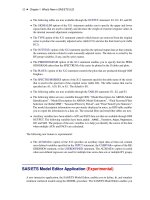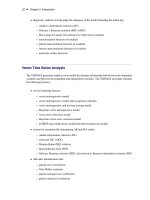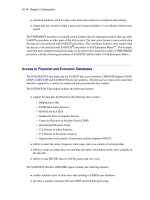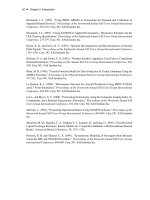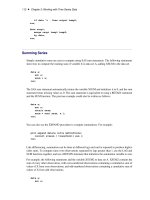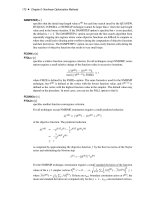SAS/ETS 9.22 User''''s Guide 13 pptx
Bạn đang xem bản rút gọn của tài liệu. Xem và tải ngay bản đầy đủ của tài liệu tại đây (261.48 KB, 10 trang )
112 ✦ Chapter 3: Working with Time Series Data
if date ^= . then output temp2;
run;
data uscpi;
merge uscpi temp1 temp2;
by date;
run;
Summing Series
Simple cumulative sums are easy to compute using SAS sum statements. The following statements
show how to compute the running sum of variable X in data set A, adding XSUM to the data set.
data a;
set a;
xsum + x;
run;
The SAS sum statement automatically retains the variable XSUM and initializes it to 0, and the sum
statement treats missing values as 0. The sum statement is equivalent to using a RETAIN statement
and the SUM function. The previous example could also be written as follows:
data a;
set a;
retain xsum;
xsum = sum( xsum, x );
run;
You can also use the EXPAND procedure to compute summations. For example:
proc expand data=a out=a method=none;
convert x=xsum / transform=( sum );
run;
Like differencing, summation can be done at different lags and can be repeated to produce higher-
order sums. To compute sums over observations separated by lags greater than 1, use the LAG and
SUM functions together, and use a RETAIN statement that initializes the summation variable to zero.
For example, the following statements add the variable XSUM2 to data set A. XSUM2 contains the
sum of every other observation, with even-numbered observations containing a cumulative sum of
values of X from even observations, and odd-numbered observations containing a cumulative sum of
values of X from odd observations.
data a;
set a;
Transforming Time Series ✦ 113
retain xsum2 0;
xsum2 = sum( lag( xsum2 ), x );
run;
Assuming that A is a quarterly data set, the following statements compute running sums of X for
each quarter. XSUM4 contains the cumulative sum of X for all observations for the same quarter
as the current quarter. Thus, for a first-quarter observation, XSUM4 contains a cumulative sum of
current and past first-quarter values.
data a;
set a;
retain xsum4 0;
xsum4 = sum( lag3( xsum4 ), x );
run;
To compute higher-order sums, repeat the preceding process and sum the summation variable. For
example, the following statements compute the first and second summations of X:
data a;
set a;
xsum + x;
x2sum + xsum;
run;
The following statements compute the second order four-period sum of X:
data a;
set a;
retain xsum4 x2sum4 0;
xsum4 = sum( lag3( xsum4 ), x );
x2sum4 = sum( lag3( x2sum4 ), xsum4 );
run;
You can also use PROC EXPAND to compute cumulative statistics and moving window statistics.
See Chapter 14, “The EXPAND Procedure,” for details.
Transforming Time Series
It is often useful to transform time series for analysis or forecasting. Many time series analysis and
forecasting methods are most appropriate for time series with an unrestricted range, a linear trend,
and a constant variance. Series that do not conform to these assumptions can often be transformed to
series for which the methods are appropriate.
Transformations can be useful for the following:
114 ✦ Chapter 3: Working with Time Series Data
range restrictions. Many time series cannot have negative values or can be limited to a
maximum possible value. You can often create a transformed series with an unbounded range.
nonlinear trends. Many economic time series grow exponentially. Exponential growth corre-
sponds to linear growth in the logarithms of the series.
series variability that changes over time. Various transformations can be used to stabilize the
variance.
nonstationarity. The %DFTEST macro can be used to test a series for nonstationarity which
can then be removed by differencing.
Log Transformation
The logarithmic transformation is often useful for series that must be greater than zero and that grow
exponentially. For example, Figure 3.17 shows a plot of an airline passenger miles series. Notice
that the series has exponential growth and the variability of the series increases over time. Airline
passenger miles must also be zero or greater.
Figure 3.17 Airline Series
Other Transformations ✦ 115
The following statements compute the logarithms of the airline series:
data lair;
set sashelp.air;
logair = log( air );
run;
Figure 3.18 shows a plot of the log-transformed airline series. Notice that the log series has a linear
trend and constant variance.
Figure 3.18 Log Airline Series
The %LOGTEST macro can help you decide if a log transformation is appropriate for a series. See
Chapter 5, “SAS Macros and Functions,” for more information about the %LOGTEST macro.
Other Transformations
The Box-Cox transformation is a general class of transformations that includes the logarithm as a
special case. The %BOXCOXAR macro can be used to find an optimal Box-Cox transformation for
a time series. See Chapter 5 for more information about the %BOXCOXAR macro.
116 ✦ Chapter 3: Working with Time Series Data
The logistic transformation is useful for variables with both an upper and a lower bound, such
as market shares. The logistic transformation is useful for proportions, percent values, relative
frequencies, or probabilities. The logistic function transforms values between 0 and 1 to values that
can range from -1 to +1.
For example, the following statements transform the variable SHARE from percent values to an
unbounded range:
data a;
set a;
lshare = log( share / ( 100 - share ) );
run;
Many other data transformation can be used. You can create virtually any desired data transformation
using DATA step statements.
The EXPAND Procedure and Data Transformations
The EXPAND procedure provides a convenient way to transform series. For example, the following
statements add variables for the logarithm of AIR and the logistic of SHARE to data set A:
proc expand data=a out=a method=none;
convert air=logair / transform=( log );
convert share=lshare / transform=( / 100 logit );
run;
See Table 14.2 in Chapter 14, “The EXPAND Procedure,” for a complete list of transformations
supported by PROC EXPAND.
Manipulating Time Series Data Sets
This section discusses merging, splitting, and transposing time series data sets and interpolating time
series data to a higher or lower sampling frequency.
Splitting and Merging Data Sets
In some cases, you might want to separate several time series that are contained in one data set into
different data sets. In other cases, you might want to combine time series from different data sets
into one data set.
Transposing Data Sets ✦ 117
To split a time series data set into two or more data sets that contain subsets of the series, use a
DATA step to create the new data sets and use the KEEP= data set option to control which series
are included in each new data set. The following statements split the USPRICE data set shown in a
previous example into two data sets, USCPI and USPPI:
data uscpi(keep=date cpi)
usppi(keep=date ppi);
set usprice;
run;
If the series have different time ranges, you can subset the time ranges of the output data sets
accordingly. For example, if you know that CPI in USPRICE has the range August 1990 through the
end of the data set, while PPI has the range from the beginning of the data set through June 1991,
you could write the previous example as follows:
data uscpi(keep=date cpi)
usppi(keep=date ppi);
set usprice;
if date >= '1aug1990'd then output uscpi;
if date <= '1jun1991'd then output usppi;
run;
To combine time series from different data sets into one data set, list the data sets to be combined in a
MERGE statement and specify the dating variable in a BY statement. The following statements show
how to combine the USCPI and USPPI data sets to produce the USPRICE data set. It is important to
use the BY DATE statement so that observations are matched by time before merging.
data usprice;
merge uscpi usppi;
by date;
run;
Transposing Data Sets
The TRANSPOSE procedure is used to transpose data sets from one form to another. The TRANS-
POSE procedure can transpose variables and observations, or transpose variables and observations
within BY groups. This section discusses some applications of the TRANSPOSE procedure relevant
to time series data sets. See the Base SAS Procedures Guide for more information about PROC
TRANSPOSE.
Transposing from Interleaved to Standard Time Series Form
The following statements transpose part of the interleaved-form output data set FOREOUT, produced
by PROC FORECAST in a previous example, to a standard form time series data set. To reduce the
volume of output produced by the example, a WHERE statement is used to subset the input data set.
118 ✦ Chapter 3: Working with Time Series Data
Observations with _TYPE_=ACTUAL are stored in the new variable ACTUAL; observations with
_TYPE_=FORECAST are stored in the new variable FORECAST; and so forth. Note that the method
used in this example works only for a single variable.
title "Original Data Set";
proc print data=foreout(obs=10);
where date > '1may1991'd & date < '1oct1991'd;
run;
proc transpose data=foreout out=trans(drop=_name_);
var cpi;
id _type_;
by date;
where date > '1may1991'd & date < '1oct1991'd;
run;
title "Transposed Data Set";
proc print data=trans(obs=10);
run;
The TRANSPOSE procedure adds the variables _NAME_ and _LABEL_ to the output data set.
These variables contain the names and labels of the variables that were transposed. In this example,
there is only one transposed variable, so _NAME_ has the value CPI for all observations. Thus,
_NAME_ and _LABEL_ are of no interest and are dropped from the output data set by using the
DROP= data set option. (If none of the variables transposed have a label, PROC TRANSPOSE does
not output the _LABEL_ variable and the DROP=_LABEL_ option produces a warning message.
You can ignore this message, or you can prevent the message by omitting _LABEL_ from the DROP=
list.)
The original and transposed data sets are shown in Figure 3.19 and Figure 3.20. (The observation
numbers shown for the original data set reflect the operation of the WHERE statement.)
Figure 3.19 Original Data Sets
Original Data Set
Obs date _TYPE_ _LEAD_ cpi
37 JUN1991 ACTUAL 0 136.000
38 JUN1991 FORECAST 0 136.146
39 JUN1991 RESIDUAL 0 -0.146
40 JUL1991 ACTUAL 0 136.200
41 JUL1991 FORECAST 0 136.566
42 JUL1991 RESIDUAL 0 -0.366
43 AUG1991 FORECAST 1 136.856
44 AUG1991 L95 1 135.723
45 AUG1991 U95 1 137.990
46 SEP1991 FORECAST 2 137.443
Transposing Data Sets ✦ 119
Figure 3.20 Transposed Data Sets
Transposed Data Set
Obs date _LABEL_ ACTUAL FORECAST RESIDUAL L95 U95
1 JUN1991 US Consumer Price Index 136.0 136.146 -0.14616 . .
2 JUL1991 US Consumer Price Index 136.2 136.566 -0.36635 . .
3 AUG1991 US Consumer Price Index . 136.856 . 135.723 137.990
4 SEP1991 US Consumer Price Index . 137.443 . 136.126 138.761
Transposing Cross-Sectional Dimensions
The following statements transpose the variable CPI in the CPICITY data set shown in a previous
example from time series cross-sectional form to a standard form time series data set. (Only a subset
of the data shown in the previous example is used here.) Note that the method shown in this example
works only for a single variable.
title "Original Data Set";
proc print data=cpicity;
run;
proc sort data=cpicity out=temp;
by date city;
run;
proc transpose data=temp out=citycpi(drop=_name_);
var cpi;
id city;
by date;
run;
title "Transposed Data Set";
proc print data=citycpi;
run;
The names of the variables in the transposed data sets are taken from the city names in the ID variable
CITY. The original and the transposed data sets are shown in Figure 3.21 and Figure 3.22.
120 ✦ Chapter 3: Working with Time Series Data
Figure 3.21 Original Data Sets
Transposed Data Set
Obs city date cpi cpilag
1 Chicago JAN90 128.1 .
2 Chicago FEB90 129.2 128.1
3 Chicago MAR90 129.5 129.2
4 Chicago APR90 130.4 129.5
5 Chicago MAY90 130.4 130.4
6 Chicago JUN90 131.7 130.4
7 Chicago JUL90 132.0 131.7
8 Los Angeles JAN90 132.1 .
9 Los Angeles FEB90 133.6 132.1
10 Los Angeles MAR90 134.5 133.6
11 Los Angeles APR90 134.2 134.5
12 Los Angeles MAY90 134.6 134.2
13 Los Angeles JUN90 135.0 134.6
14 Los Angeles JUL90 135.6 135.0
15 New York JAN90 135.1 .
16 New York FEB90 135.3 135.1
17 New York MAR90 136.6 135.3
18 New York APR90 137.3 136.6
19 New York MAY90 137.2 137.3
20 New York JUN90 137.1 137.2
21 New York JUL90 138.4 137.1
Figure 3.22 Transposed Data Sets
Transposed Data Set
Los_
Obs date Chicago Angeles New_York
1 JAN90 128.1 132.1 135.1
2 FEB90 129.2 133.6 135.3
3 MAR90 129.5 134.5 136.6
4 APR90 130.4 134.2 137.3
5 MAY90 130.4 134.6 137.2
6 JUN90 131.7 135.0 137.1
7 JUL90 132.0 135.6 138.4
The following statements transpose the CITYCPI data set back to the original form of the CPICITY
data set. The variable _NAME_ is added to the data set to tell PROC TRANSPOSE the name of
the variable in which to store the observations in the transposed data set. (If the (DROP=_NAME_
_LABEL_) option were omitted from the first PROC TRANSPOSE step, this would not be necessary.
PROC TRANSPOSE assumes ID _NAME_ by default.)
The NAME=CITY option in the PROC TRANSPOSE statement causes PROC TRANSPOSE to
store the names of the transposed variables in the variable CITY. Because PROC TRANSPOSE
recodes the values of the CITY variable to create valid SAS variable names in the transposed data
set, the values of the variable CITY in the retransposed data set are not the same as in the original.
Time Series Interpolation ✦ 121
The retransposed data set is shown in Figure 3.23.
data temp;
set citycpi;
_name_ = 'CPI';
run;
proc transpose data=temp out=retrans name=city;
by date;
run;
proc sort data=retrans;
by city date;
run;
title "Retransposed Data Set";
proc print data=retrans;
run;
Figure 3.23 Data Set Transposed Back to Original Form
Retransposed Data Set
Obs date city CPI
1 JAN90 Chicago 128.1
2 FEB90 Chicago 129.2
3 MAR90 Chicago 129.5
4 APR90 Chicago 130.4
5 MAY90 Chicago 130.4
6 JUN90 Chicago 131.7
7 JUL90 Chicago 132.0
8 JAN90 Los_Angeles 132.1
9 FEB90 Los_Angeles 133.6
10 MAR90 Los_Angeles 134.5
11 APR90 Los_Angeles 134.2
12 MAY90 Los_Angeles 134.6
13 JUN90 Los_Angeles 135.0
14 JUL90 Los_Angeles 135.6
15 JAN90 New_York 135.1
16 FEB90 New_York 135.3
17 MAR90 New_York 136.6
18 APR90 New_York 137.3
19 MAY90 New_York 137.2
20 JUN90 New_York 137.1
21 JUL90 New_York 138.4
Time Series Interpolation
The EXPAND procedure interpolates time series. This section provides a brief summary of the use
of PROC EXPAND for different kinds of time series interpolation problems. Most of the issues
discussed in this section are explained in greater detail in Chapter 14.



